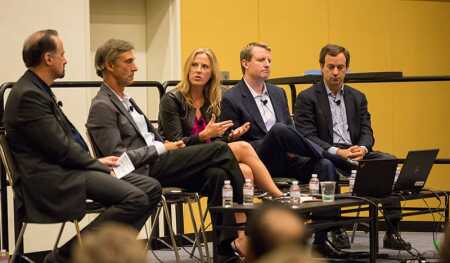
From left: Anton N. Natsis, partner, Allen Matkins Leck Gamble Mallory & Natsis LLP; Jay Bechtel, real estate project executive, Google; Kate Bicknell, senior vice president of Forest City Ratner Companies; Mike Sanford, executive vice president, northern California, Kilroy Realty Corporation; and Matt Field, chief investment officer, TMG Partners.
Developers who are trying to fill the ever-expanding demands of technology companies have learned a few things about their clients: They want a place to park their bikes; they like bringing their dogs to work; and, above all, they love rooftop decks.
“Not only are they out on the decks 24/7, but they even conduct job interviews there,” explained Mike Sanford, an executive vice president for Kilroy Realty, a California-based developer with a portfolio of clients that includes prominent firms such as Dropbox, LinkedIn, and Salesforce.
Similarly, on the other side of the nation in New York City, “We’re seeing a proliferation of rooftop decks across the city in the last six or seven years,” noted Kate Bicknell, senior vice president of Forest City Ratner Companies. “And we do have lots of bikes, and lots of dogs.”
But participants at a panel at ULI’s Fall Meeting in San Francisco agreed that tech companies’ most pressing need is for large amounts of space to accommodate operations that often scale up practically overnight to take advantage of rapidly emerging business opportunities. Some of the biggest tech companies are growing so rapidly that they have taken to buying buildings that are already occupied by other technology tenants, and wait for leases to expire so that they can take over the space. Those moves are sending ripples throughout the marketplace, as developers scramble to provide space for the smaller companies that end up moving.
“There’s a displacement effect,” explained Matt Field, chief investment officer for San Francisco–based developer TMG Partners. “We try to stay in front of it, and keep an eye on the stuff that we foresee Google or Apple not renewing. There is this massive displacement, which we see as an opportunity.”
The technology boom has created a burgeoning real estate market in major cities on both coasts, panelists said. Despite developers’ efforts, Google real estate project executive Jay Bechtel still complained of a dearth of supply. “Our questions are, ‘is it vacant?’ and, ‘Can I buy it?’ ” he said.
Bechtel jokingly described his Google colleagues as “the world’s greatest hermit crabs” because of the company’s practice of acquiring buildings and gutting them to create the sort of open workplace environment—as well as amenities such as outdoor cafés and athletic facilities—that have become Google hallmarks. In the Silicon Valley community of Mountain View, Google is trying to connect its properties to create a massive campus, even carving bike routes through buildings, he said.
In San Francisco, developers have been busy repurposing old industrial and commercial buildings to fit tech companies’ clamor for large amounts of floor space. Kilroy, for example, acquired a flower mart in the city’s SoMa neighborhood and is turning it into 1.5 million square feet (139,000 sq m) of space for technology companies, plus retail and a café, that it anticipates completing in 2019 or 2020. To maintain the site’s distinctive ambience, Kilroy is keeping the flower mart as well. Another Kilroy project in San Francisco, One Hundred Cooper, will allocate 400,000 square feet (37,000 sq m) of space to both offices and production, distribution, and repair, or PDF, uses. Sanford said that the project will help San Francisco in its efforts to keep manufacturers in the city, and will help forge collaborations between manufacturers and technology outfits.
Yet another Kilroy project—the Exchange on Sixteenth in the Mission Bay neighborhood—is aimed at both technology companies and life sciences outfits. To create flexibility for tenants, “we designed the project to have either use,” Sanford said.
In New York City, Forest City Ratner is partnering with Cornell University to build a new $2 billion technology campus on Roosevelt Island in the East River, between Manhattan and Queens. The project, which will create a nexus for graduate engineering students and big technology companies such as Google, Qualcomm, Uber, and Twitter, is designed to facilitate what Bicknell calls “a new model of graduate education in which students don’t have to leave industry.”





